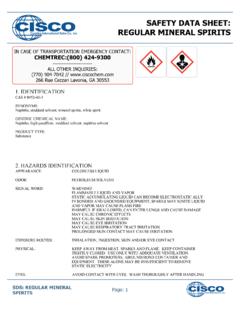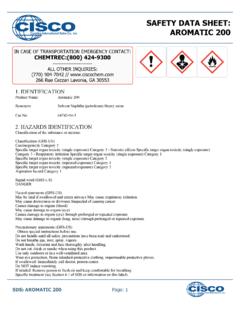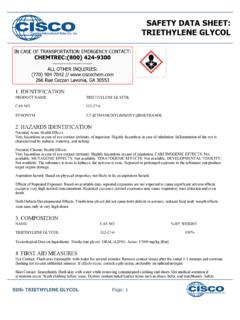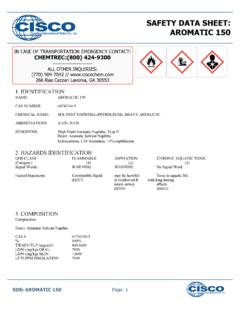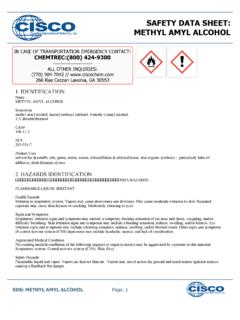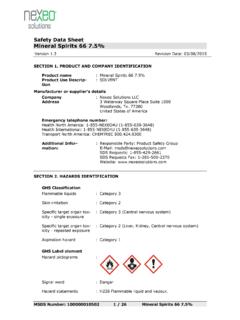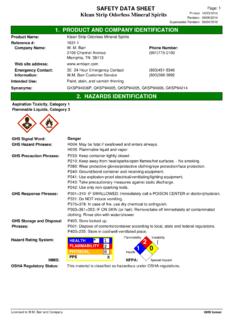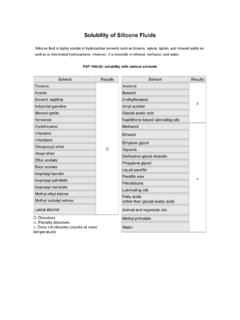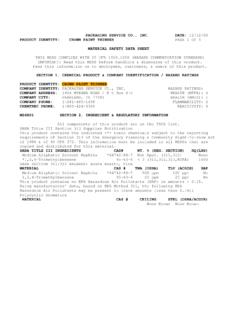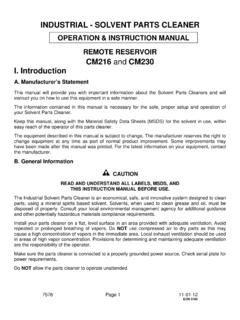Transcription of SAFETY DATA SHEET: ODORLESS MINERAL SPIRITS
1 SAFETY data sheet : ODORLESS MINERAL SPIRITS1. IDENTIFICATIONO dorless MINERAL SpiritsCAS # 68551-19-92. HAZARDS IDENTIFICATIONC lassification of the substance or mixtureThis product has been classified in accordance with the hazard communication standard 29 CFR ; the SDS and labelscontain all the information as required by the OverviewDangerForm: LiquidPhysical state: LiquidColor: Colorless at room temperatureOdor: Mild, HydrocarbonOSHA Hazards : Combustible Liquid, Aspiration hazardClassificationFlammable liquids , Category 4 Aspiration hazard , Category 1 Signal word:DangerHazard Statements:Combustible liquidMay be fatal if swallowed and enters airwaysPrecautionary Statements:Prevention:Keep away from heat/sparks/open flames/hot surfaces. - No smoking.
2 Wear protective gloves/ eye protection/ face :IN CASE OF TRANSPORTATION EMERGENCY CONTACT:CHEMTREC:(800) 424-9300-----------------------ALL OTHER INQUIRIES:(770) 904-7042 // Rue Cezzan Lavonia, GA 30553 Page: 1 SDS: ODORLESS MINERALSPIRITSIF SWALLOWED: Immediately call a POISON CENTER or doctor. Do NOT induce case of a fire: Use dry sand, dry chemical or alcohol-resistant foam for : Store in a well-ventilated place, keep cool. Store locked upDisposal: Dispose of contents/container to an approved waste disposal :IARC:No ingredient of this product present at levels greater than or equal to is identified as probable, possible or confirmed humancarcinogen by :No ingredient of this product present at levels greater than or equal to is identified as a known or anticipated carcinogen :No ingredient of this product present at levels greater than or equal to is identified as a carcinogen or potential carcinogen COMPOSITIONS ynonyms : IsoalkanesIsoparaffinsAliphatic hydrocarbonMolecular formula : UVCBCOMPONENTCAS #WEIGHT %C12-C14 Isoalkanes68551-19-9 100%4.
3 FIRST AID MEASURESGENERAL ADVICE:Move out of dangerous area. Show this material SAFETY data sheet to the doctor in attendance. Material may produce a serious,potentially fatal pneumonia if swallowed or INHALED:If unconscious place in recovery position and seek medical advice. If symptoms persist, call a CASE OF SKIN CONTACT:If on skin, rinse well with water. If on clothes, remove CASE OF EYE CONTACT:Flush eyes with water as a precaution. Remove contact lenses. Protect unharmed eye. Keep eye wide open while rinsing. If eyeirritation persists, consult a SWALLOWED:Keep respiratory tract clear. Never give anything by mouth to an unconscious person. If symptoms persist, call a physician. Takevictim immediately to FIRE FIGHTING MEASURESF lash point61 C (142 F)Method Tag closed cupAutoignition temperature230 C (446 F)Page: 2 SDS: ODORLESS MINERALSPIRITSS uitable extinguishing mediaAlcohol-resistant foam.
4 Carbon Dioxide (Co2) Dry ChemicalUnsuitable extinguishing mediaHigh volume water jetSpecial protective equipment for fire-fightersWear self-contained breathing apparatus for firefighting if necessaryFurther informationFor SAFETY reasons in case of fire, cans should be stored separatelyin closed containments. Use a water spray to cool fully and explosion protectionDo not spray on an open flame or any other incandescent away from open flames, hot surfaces and sources of ignitionHazardous decomposition productsCarbon Dioxides6. ACCIDENTAL RELEASE MEASURESP ersonal precautions :Use personal protective equipment. Ensure adequate precautions :Prevent product from entering drains. Prevent further leakage or spillage if safe to do so. If the product contaminates rivers and lakesor drains inform respective for cleaning up :Contain spillage, and then collect with non-combustible absorbent material, ( sand, earth, diatomaceous earth,vermiculite) and place in container for disposal according to local / national regulations (see section 13).
5 Keep in suitable, closedcontainers for HANDLING AND STORAGEH andlingAdvice on safe handlingAvoid formation of aerosol. Do not breathe vapors/dust. For personal protection see section 8. Smoking, eating and drinking shouldbe prohibited in the application area. Provide sufficient air exchange and/or exhaust in work rooms. Dispose of rinse water inaccordance with local and national on protection against fire and explosionDo not spray on an open flame or any other incandescent material. Keep away from open flames, hot surfaces and sources for storage areas and containersNo smoking. Keep container tightly closed in a dry and well- ventilated place. Observe label precautions. Electrical installations /working materials must comply with the technological SAFETY EXPOSURE CONTROLS AND PERSONAL PROECTIONI ngredients with workplace control parametersIngedientsValueControl parametersNoteC12-C14 IsoalkanesTWA1,200 mg/m3 RCPRCP = Reciprocal Calculation ProcedureEngineering measuresAdequate ventilation to control airborned concentrations below the exposure guidelines/limits.
6 Consider the potential hazards of thisPage: 3 SDS: ODORLESS MINERALSPIRITS material (see Section 2), applicable exposure limits, job activities, and other substances in the work place when designingengineering controls and selecting personal protective equipment. If engineering controls or work practices are not adequate toprevent exposure to harmful levels of this material, the personal protective equipment listed below is recommended. The user shouldread and understand all instructions and limitations supplied with the equipment since protection is usually provided for a limitedtime or under certain protective equipmentRespiratory protectionWear a supplied-air NIOSH approved respirator unless ventilation or other engineering controls are adequate to maintain minimaloxygen content of by volume under normal atmospheric pressure.
7 Wear a NIOSH approved respirator that providesprotection when working with this material if exposure to harmful levels of airborne material may occur, such as:. Air-PurifyingRespirator for Organic Vapors. Use a positive pressure, air-supplying respirator if there is potential for uncontrolled release,exposure levels are not known, or other circumstances where air-purifying respirators may not provide adequate ProtectionThe suitability for a specific workplace should be discussed with the producers of the protective gloves. Please observe theinstructions regarding permeability and breakthrough time which are provided by the supplier of the gloves. Also take intoconsideration the specific local conditions under which the product is used, such as the danger of cuts, abrasion, and the contact should be discarded and replaced if there is any indication of degradation or chemical ProtectionEye wash bottle with pure water.
8 Tightly fitting SAFETY and body protectionChoose body protection according to the amount and concentration of the dangerous substance at the work place. Wear asappropriate:. Flame-resistant clothing. Footwear protecting against measuresWhen using do not eat or drink. When using do not smoke. Wash hands before breaks and at the end of PHYSICAL AND CHEMICAL PROPERTIESI nformation on basic physical and chemical propertiesAppearanceFormLiquidPhysical StateLiquidColorColorless at room temperatureOdorMild, hydrocarbonSAFETY DATAF lash Point61 C (142 F)Method: Tag closed cupLower explosion (V)Upper explosion (V)Oxidizing propertiesnoPage: 4 SDS: ODORLESS MINERALSPIRITSA utoignition temperature230 C (446 F)Thermal decompositionno data availableMolecular formulaUVCBM olecular weightNot applicablepH7pour pointno data availableBoiling/Point & range179 - 210 C (354 - 410 F)Vapor MMHG @ 38 C (100 F)Relative , C ( F)Water SolubilitynegligiblePartition coefficient.
9 N-octanol/waterNo data availableViscosity, cSt @ 38 C (100 F)Relative vapor density3 (Air = )Evaporation rate1 Percent volatile>99%10. STABILITY AND REACTIVITYC hemical stability : This material is considered stable under normal ambient and anticipated storage and handling conditions oftemperature and of hazardous reactionsConditions to avoidHeat, flames and sparksMaterials to avoidmay react with oxygen and strong oxidizing agents, such aschlorates, nitrates, peroxides, decompositionNo data availableHazardous decomposition productsCarbon oxidesOther dataNo decomposition if stored and applied as directed11. TOXICOLOGICAL INFORMATIONA cute oral toxicityC12-C14 IsoalkanesLD50: > 5000 milligram per kilogramSpecies: ratPage: 5 SDS: ODORLESS MINERALSPIRITSM ethod: OECD Test Guideline 401 Information given is based on data obtained from similar inhalation toxicityC12-C14 IsoalkanesLC50: > per literExposure time: 4 hSpecies: ratTest atmosphere: vaporMethod: OECD Test Guideline 403 Information given is based on data obtained from similar irritationC12-C14 IsoalkanesNo skin irritationInformation given is based on data obtained from similar irritationC12-C14 IsoalkanesNo eye irritationInformation given is based on data obtained from similar IsoalkanesClassification.
10 Did not cause sensitization on laboratory given is based on data obtained from similar dose toxicityC12-C14 IsoalkanesSpecies: MonkeyApplication Route: InhalationDose: 0, 654 ppmExposure time: 4 wkNumber of exposures: 6 h/d, 3 d/wk NOEL: > 654 ppmMethod: OECD Test Guideline 412 Species: rat, male and female Sex: male and female Application Route: oral gavage Dose: 0, 25, 150, 1000 mg/kg/d Exposure time:4 wkNumber of exposures: dailyNOEL: >= 1000 mg/kg/dMethod: OECD Guideline 422 Information given is based on data obtained from similar toxicityC12-C14 IsoalkanesSpecies: ratSex: maleApplication Route: oral gavageDose: 0, 750, 1500, 3000 mg/kg/bw/dNumber of exposures: dailyTest period: 90 dMethod: OECD Test Guideline 415 NOAEL Parent: >= 3000 mg/kg/bw/dInformation given is based on data obtained from similar : ratSex: femaleApplication Route: oral gavageDose: 0, 750, 1500 mg/kg/bw/dNumber of exposures: dailyTest period: 90 dMethod: OECD Test Guideline 415 NOAEL Parent: >= 1500 mg/kg/bw/dPage: 6 SDS: ODORLESS MINERALSPIRITSNOAEL F1: 750 mg/kg/bw/dInformation given is based on data obtained from similar : ratSex: male and femaleApplication Route: inhalation (vapor)Dose: 100, 300 ppmNumber of exposures: 6 h/d/5d/wkTest period: 8 wkMethod: OECD Guideline 421 NOAEL Parent: >= 300 ppmNOAEL F1: >= 300 ppmInformation given is based on data obtained from similar ToxicityC12-C14 IsoalkanesSpecies: ratApplication Route: InhalationDose: 100, 300 ppmExposure time: GD 6-15 Number of exposures.
